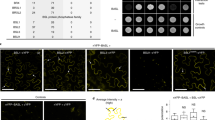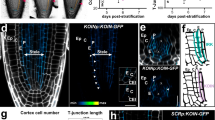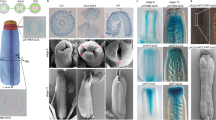Abstract
Pre-mitotic establishment of polarity is a key event in the preparation of mother cells for asymmetric cell divisions that produce daughters of distinct fates, and ensures correct cellular patterning of tissues and eventual organ function. Previous work has shown that two receptor-like kinases, PANGLOSS2 (PAN2) and PAN1, and the small GTPase RHO GTPASE OF PLANTS (ROP) promote mother cell polarity and subsequent division asymmetry in developing maize stomata. PAN proteins become polarized prior to asymmetric cell division, however, the mechanism of this polarization is unknown. Here we show that the SCAR/WAVE regulatory complex, which activates the actin-nucleating ARP2/3 complex, is the first known marker of polarity in this asymmetric division model and is required for PAN polarization. These findings implicate actin, and specifically branched actin networks, in PAN polarization and asymmetric cell division.
This is a preview of subscription content, access via your institution
Access options
Subscribe to this journal
Receive 12 digital issues and online access to articles
$119.00 per year
only $9.92 per issue
Buy this article
- Purchase on Springer Link
- Instant access to full article PDF
Prices may be subject to local taxes which are calculated during checkout






Similar content being viewed by others
References
Dow, G. J. & Bergmann, D. C. Patterning and processes: how stomatal development defines physiological potential. Curr. Opin. Plant Biol. 21, 67–74 (2014).
Pillitteri, L. J. & Torii, K. U. Mechanisms of stomatal development. Annu. Rev. Plant Biol. 63, 591–614 (2012).
Facette, M. R. & Smith, L. G. Division polarity in developing stomata. Curr. Opin. Plant Biol. 15, 585–592 (2012).
Stebbins, G. L. & Shah, S. S. Developmental studies of cell differentiation in the epidermis of monocotyledons: II. Cytological features of stomatal development in the Gramineae. Dev. Biol. 2, 477–500 (1960).
Gallagher, K. & Smith, L. G. Roles for polarity and nuclear determinants in specifying daughter cell fates after an asymmetric cell division in the maize leaf. Curr. Biol. 10, 1229–1232 (2000).
Cartwright, H. N., Humphries, J. A. & Smith, L. G. PAN1: A receptor-like protein that promotes polarization of an asymmetric cell division in maize. Science 323, 649–651 (2009).
Zhang, X. et al. Identification of PAN2 by quantitative proteomics as a leucine-rich repeat-receptor-like kinase acting upstream of PAN1 to polarize cell division in maize. Plant Cell 24, 4577–4589 (2012).
Humphries, J. A. et al. ROP GTPases act with the receptor-like protein PAN1 to polarize asymmetric cell division in maize. Plant Cell 23, 2273–2284 (2011).
Frank, M. J., Cartwright, H. N. & Smith, L. G. Three Brick genes have distinct functions in a common pathway promoting polarized cell division and cell morphogenesis in the maize leaf epidermis. Development 130, 753–762 (2003).
Frank, M. J. & Smith, L. G. A small, novel protein highly conserved in plants and animals promotes the polarized growth and division of maize leaf epidermal cells. Curr. Biol. 12, 849–853 (2002).
Miki, H., Suetsugu, S. & Takenawa, T. WAVE, a novel WASP-family protein involved in actin reorganization induced by Rac. EMBO J. 17, 6932–6941 (1998).
Machesky, L. M. et al. Scar, a WASp-related protein, activates nucleation of actin filaments by the Arp2/3 complex. Proc. Natl Acad. Sci. USA 96, 3739–3744 (1999).
Basu, D., El-Assal Sel, D., Le, J., Mallery, E. L. & Szymanski, D. B. Interchangeable functions of Arabidopsis PIROGI and the human WAVE complex subunit SRA1 during leaf epidermal development. Development 131, 4345–4355 (2004).
Deeks, M. J., Kaloriti, D., Davies, B ., Malhó, R. & Hussey, P. J. Arabidopsis NAP1 Is essential for Arp2/3-dependent trichome morphogenesis. Curr. Biol. 14, 1410–1414 (2004).
Dyachok, J. et al. SCAR mediates light-induced root elongation in Arabidopsis through photoreceptors and proteasomes. Plant Cell 23, 3610–3626 (2011).
Dyachok, J. et al. Plasma membrane-associated SCAR complex subunits promote cortical F-actin accumulation and normal growth characteristics in Arabidopsis roots. Mol. Plant 1, 990–1006 (2008).
Djakovic, S., Dyachok, J., Burke, M., Frank, M. J. & Smith, L. G. BRICK1/HSPC300 functions with SCAR and the ARP2/3 complex to regulate epidermal cell shape in Arabidopsis. Development 133, 1091–1100 (2006).
Le, J., Mallery, E. L., Zhang, C., Brankle, S. & Szymanski, D. B. Arabidopsis BRICK1/HSPC300 is an essential WAVE-complex subunit that selectively stabilizes the Arp2/3 Activator SCAR2. Curr. Biol. 16, 895–901 (2006).
Li, S., Blanchoin, L., Yang, Z. & Lord, E. M. The putative Arabidopsis Arp2/3 complex controls leaf cell morphogenesis. Plant Physiol. 132, 2034–2044 (2003).
Mathur, J., Mathur, N., Kernebeck, B. & Hulskamp, M. Mutations in ACTIN-RELATED PROTEINS 2 and 3 affect cell shape development in Arabidopsis. Plant Cell 15, 1632–1645 (2003).
El-Din El-Assal, S., Le, J., Basu, D., Mallery, E. L. & Szymanski, D. B. DISTORTED2 encodes an ARPC2 subunit of the putative Arabidopsis ARP2/3 complex. Plant J. 38, 526–538 (2004).
Duan, Q., Kita, D., Li, C., Cheung, A. Y. & Wu, H.-M. FERONIA receptor-like kinase regulates RHO GTPase signaling of root hair development. Proc. Natl Acad. Sci. USA 107, 17821–17826 (2010).
Xu, T. et al. Cell surface ABP1-TMK auxin-sensing complex activates ROP GTPase signaling. Science 343, 1025–1028 (2014).
Zhang, Y. & McCormick, S. A distinct mechanism regulating a pollen-specific guanine nucleotide exchange factor for the small GTPase Rop in Arabidopsis thaliana. Proc. Natl Acad. Sci. USA 104, 18830–18835 (2007).
Zhao, X.-Y. et al. The juxtamembrane and carboxy-terminal domains of Arabidopsis PRK2 are critical for ROP-induced growth in pollen tubes. J. Exp. Bot. 64, 5599–5610 (2013).
Gachomo, E. W., Jno Baptiste, L., Kefela, T., Saidel, W. M. & Kotchoni, S. O. The Arabidopsis CURVY1 (CVY1) gene encoding a novel receptor-like protein kinase regulates cell morphogenesis, flowering time and seed production. BMC Plant Biol. 14, 221 (2014).
Fu, Y., Li, H. & Yang, Z. The ROP2 GTPase controls the formation of cortical fine F-Actin and the early phase of directional cell expansion during Arabidopsis organogenesis. Plant Cell 14, 777–794 (2002).
El-Assal, S. E.-D., Le, J., Basu, D., Mallery, E. L. & Szymanski, D. B. Arabidopsis GNARLED encodes a NAP125 homolog that positively regulates ARP2/3. Curr. Biol. 14, 1405–1409 (2004).
Kitamura, T. et al. Molecular cloning of p125Nap1, a protein that associates with an SH3 Domain of Nck. Biochem. Biophys. Res. Commun. 219, 509–514 (1996).
Eden, S., Rohatgi, R., Podtelejnikov, A. V., Mann, M. & Kirschner, M. W. Mechanism of regulation of WAVE1-induced actin nucleation by Rac1 and Nck. Nature 418, 790–793 (2002).
Zhang, C. et al. The endoplasmic reticulum is a reservoir for WAVE/SCAR regulatory complex signaling in the Arabidopsis leaf. Plant Physiol. 162, 689–706 (2013).
Giannoutsou, E., Apostolakos, P. & Galatis, B. Actin filament-organized local cortical endoplasmic reticulum aggregations in developing stomatal complexes of grasses. Protoplasma 248, 373–390 (2011).
Sowa, M. E., Bennett, E. J., Gygi, S. P. & Harper, J. W. Defining the human deubiquitinating enzyme interaction landscape. Cell 138, 389–403 (2009).
Jörgens, C. I., Grünewald, N., Hülskamp, M. & Uhrig, J. F. A role for ABIL3 in plant cell morphogenesis. Plant J. 62, 925–935 (2010).
Uhrig, J. F. et al. The role of Arabidopsis SCAR genes in ARP2-ARP3-dependent cell morphogenesis. Development 134, 967–977 (2007).
Derivery, E. et al. Free Brick1 is a trimeric precursor in the assembly of a functional wave complex. PLoS ONE 3, e2462 (2008).
Kunda, P., Craig, G., Dominguez, V. & Baum, B. Abi, Sra1, and Kette control the stability and localization of SCAR/WAVE to regulate the formation of actin-based protrusions. Curr. Biol. 13, 1867–1875 (2003).
Blagg, S. L., Stewart, M., Sambles, C. & Insall, R. H. PIR121 regulates pseudopod dynamics and SCAR activity in Dictyostelium. Curr. Biol. 13, 1480–1487 (2003).
Ibarra, N., Blagg, S. L., Vazquez, F. & Insall, R. H. Nap1 regulates Dictyostelium cell motility and adhesion through SCAR-dependent and -independent pathways. Curr. Biol. 16, 717–722 (2006).
Linkner, J., Witte, G., Stradal, T., Curth, U. & Faix, J. High-resolution X-Ray structure of the trimeric Scar/WAVE-Complex Precursor Brk1. PLoS ONE 6, e21327 (2011).
Sutimantanapi, D., Pater, D. & Smith, L. G. Divergent roles for maize PAN1 and PAN2 receptor-like proteins in cytokinesis and cell morphogenesis. Plant Physiol. 164, 1905–1917 (2014).
Mohanty, A. et al. Advancing cell biology and functional genomics in maize using fluorescent protein-tagged lines. Plant Physiol. 149, 601–605 (2009).
Lebensohn, A. M. & Kirschner, M. W. Activation of the WAVE complex by coincident signals controls actin assembly. Mol. Cell 36, 512–524 (2009).
Chen, Z. et al. Structure and control of the actin regulatory WAVE complex. Nature 468, 533–538 (2010).
Geldner, N., Friml, J., Stierhof, Y.-D., Jurgens, G. & Palme, K. Auxin transport inhibitors block PIN1 cycling and vesicle trafficking. Nature 413, 425–428 (2001).
Lin, D. et al. A ROP GTPase-dependent auxin signaling pathway regulates the subcellular distribution of PIN2 in Arabidopsis roots. Curr. Biol. 22, 1319–1325 (2012).
Nagawa, S. et al. ROP GTPase-dependent actin microfilaments promote PIN1 polarization by localized inhibition of clathrin-dependent endocytosis. PLoS Biol. 10, e1001299 (2012).
Li, G. et al. Rice actin-binding protein RMD is a key link in the auxin–actin regulatory loop that controls cell growth. Proc. Natl Acad. Sci. USA 111, 10377–10382 (2014).
Chen, B. et al. The WAVE regulatory complex links diverse receptors to the actin cytoskeleton. Cell 156, 195–207 (2014).
Schindelin, J. et al. Fiji: an open-source platform for biological-image analysis. Nature Meth. 9, 676–682 (2012).
Acknowledgements
We thank Kaiyue Deng for collecting complementation data in Supplementary Fig. 2 and the BICD101 class of 2009 at UC San Diego for sequencing brk3 alleles. This work was supported by NSF grants IOS-1147265 to LGS, NSF-1027446 to AWS, and a New Scholar Award from the Ellison Medical Foundation to EJB.
Author information
Authors and Affiliations
Contributions
M.R.F. and L.G.S. planned the experiments. M.R.F., Y.P., D.S., and H.N.C. performed the microscopy. M.R.F. performed the co-IP/western blots and M.R.F., B.Y., and E.J.B. performed the co-IP/MS. A.L. and A.W.S. made the –CFP and –YFP constructs and supplied transgenic plants. M.R.F., Y.P. and L.G.S. analysed the data. M.R.F. wrote the manuscript with input from other authors.
Corresponding authors
Ethics declarations
Competing interests
The authors declare no competing financial interests.
Supplementary information
Rights and permissions
About this article
Cite this article
Facette, M., Park, Y., Sutimantanapi, D. et al. The SCAR/WAVE complex polarizes PAN receptors and promotes division asymmetry in maize. Nature Plants 1, 14024 (2015). https://doi.org/10.1038/nplants.2014.24
Received:
Accepted:
Published:
DOI: https://doi.org/10.1038/nplants.2014.24
This article is cited by
-
Crystal structure of DRIK1, a stress-responsive receptor-like pseudokinase, reveals the molecular basis for the absence of ATP binding
BMC Plant Biology (2020)
-
Putative RopGAPs impact division plane selection and interact with kinesin-12 POK1
Nature Plants (2016)
-
Spatio-temporal diversification of the cell wall matrix materials in the developing stomatal complexes of Zea mays
Planta (2016)
-
Asymmetric cell division in plants: mechanisms of symmetry breaking and cell fate determination
Cellular and Molecular Life Sciences (2016)
-
Deliberate ROS production and auxin synergistically trigger the asymmetrical division generating the subsidiary cells in Zea mays stomatal complexes
Protoplasma (2016)



